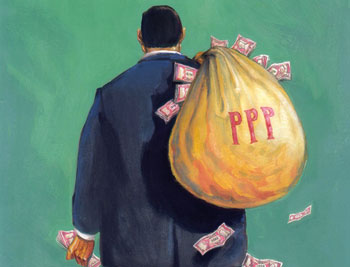Put privately executed infrastructure projects under CAG before setting gargantuan investment targets
To figure out how much we the people matter in prime minister Manmohan Singh’s vision of economy, a visit to the Delhi-Gurgaon border would be ideal. From some vantage point, take a look at the airport, the metro line connecting it with the city centre, and the expressway to the satellite township of Gurgaon. Three projects of international scale that showcase to the world the India story. And also what’s wrong with it.
All three projects came up under what has become the signature tune of Manmohan Singh’s tenure as prime minister: public-private partnerships, or PPPs. In end-June, he set an investment target of Rs 1.15 lakh crore through PPPs in infrastructure sectors for the next six months. This could well be his swan song.
PPPs in themselves are nothing wrong. We are told on good authority that (a) robust infrastructure (which means roads, railways, airports, ports and so on including most importantly power) is crucial if India is ever going to return towards a double-digit growth, and (b) the public exchequer itself does not have enough money to build all those roads and so on. Hence the PPPs.
Done't miss: A primer on PPP in plain English (see PDF attached below)
The trouble is, PPPs are to greenfield (new and upcoming) projects what privatisation is to brownfield (existing) projects. And when policymakers deals with corporate, public interest is often the last priority. That is why, PPPs have earned a bad reputation. They have come to stand for ‘pure and private pelf’, which incidentally was the headline of our exhaustively researched cover story on this business in October 2010 (See PDFs attached).
Simply put, like privatisation, in PPPs profits go to the private parties and risks to the state – losses for the public in either case. Take, for example, the Delhi-Gurgaon expressway. While the cover story attached below shows beyond doubts how tens of thousands of people are being fleeced day in and day out, here is one nugget: while 14 years would have been enough for the concessionaire (the private contractor) to recoup his investments and generate a reasonable rate of return, the national highway authority of India (NHAI) allowed a concession period of 20 years, according to the comptroller and auditor general (CAG). Thus, the concessionaire would gain Rs 187.77 crore over the extra six years – directly from our pockets.
Another example is more recent,: the airport line of the Delhi Metro. This was the only phase of the transport project given out to a private party (Anil Ambani group) in PPP – despite opposition from Metro chairman E Sreedharan, this was the only phase that faced delays, this was the only portion where construction left hazardous security risks. Within months of going operational, it had to be shut down without prior notice (which sounds like a project from some banana republic), and now the private player has decided to exit it. The Delhi Metro and the public have been taken for a ride by the private party.
We don’t have to go far for yet another example of the perils of PPP; it is right where the above two projects meet, the Delhi airport. For more read: Dial D for disaster: Delhi airport highlights perils of PPP
And yet the prime minister insists on the PPP mode, envisaging a huge investment before the yearend. If the investments are so badly needed, so be it, but why don’t they put some rules of the game in place? For starters, how about increasing transparency? This can be done in two ways: through RTI and CAG.
All these years, PPPs refused to give out information, arguing they were private entities even as they enjoyed public privileges. However, after a long fight by activists (see, for example, Where is 'public' in PPP?), the government earlier this year agreed that PPPs do come under this law. In detailed guidelines issued in April, the department of personnel and training made it clear that “all information relating to PPPs must be disclosed in the public domain” henceforth suo motu, as per provisions of section 4 of the RTI Act. (Read more: “Out of shadow, PPPs at last come under RTI ambit”) However, this is still a matter of guideline, and activists will have to fight on case-to-case basis.
CAG auditing is more convincing way of ensuring some public interest in PPP – and to avoid the kind of fiascos we have seen close to the Delhi-Gurgaon border. Former CAG Vinod Rai as well as vice president Hamid Ansari and Lok Sabha speaker Meira Kumar. The PM too apparently favoured the idea more than two years ago (PM hints CAG be permitted to go into PPP accounts), and some select PPPs have been audited by CAG, but as of today PPPs are not part of CAG’s mandate. That should be the top priority before inviting further investments.

